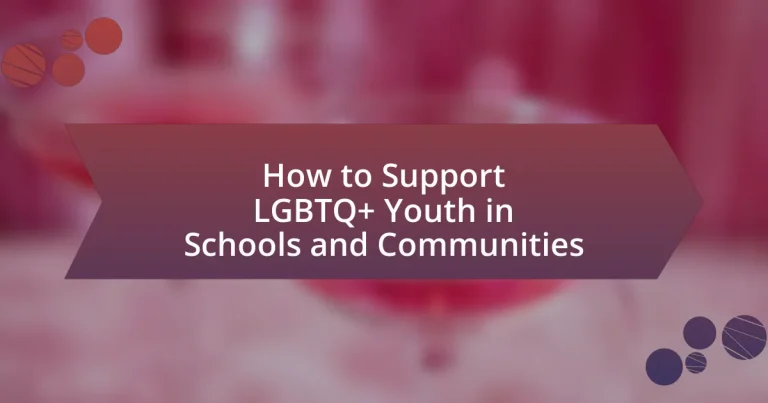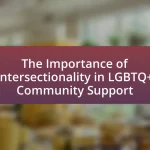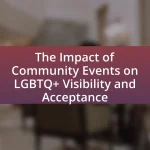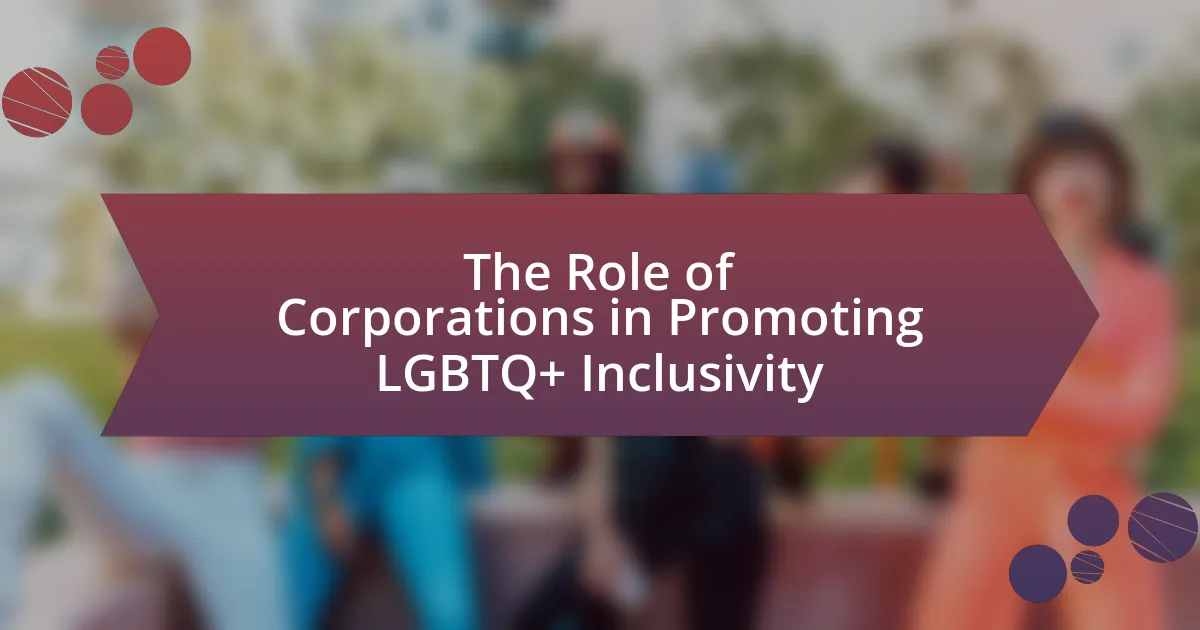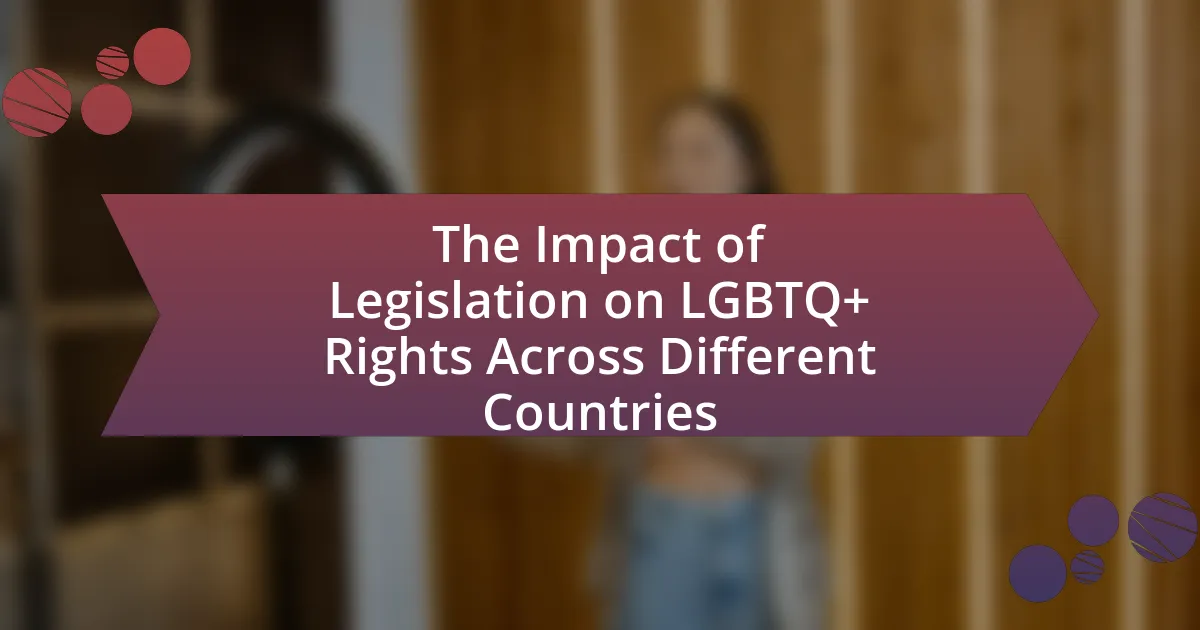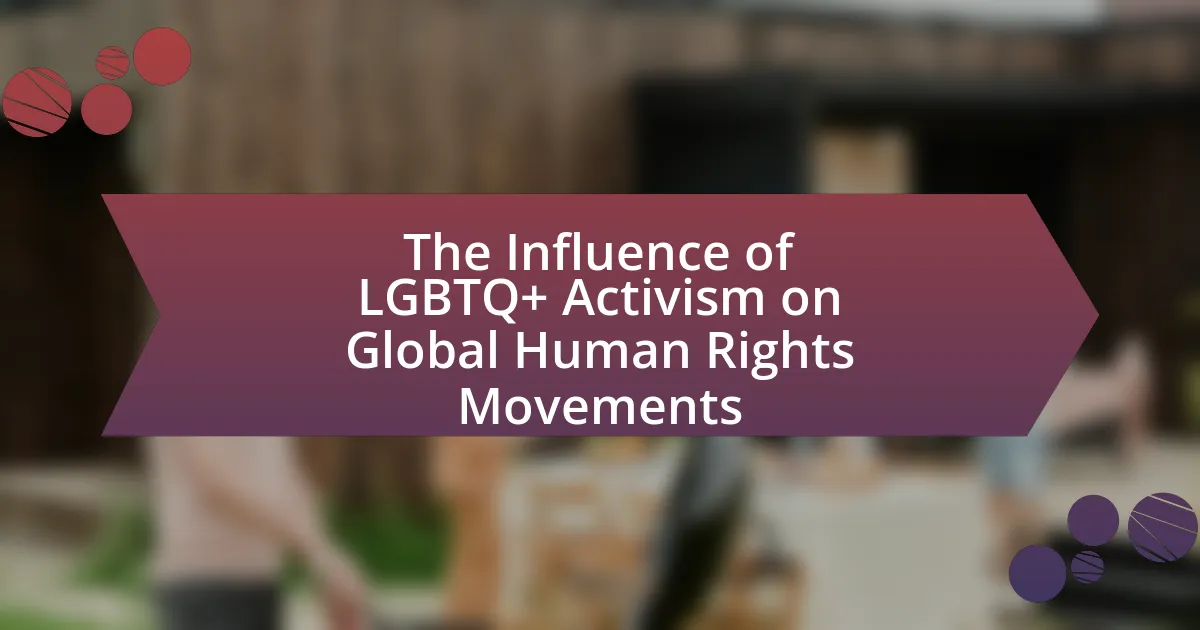Supporting LGBTQ+ youth in schools and communities involves creating inclusive environments that affirm their identities and address their unique challenges. This article outlines the importance of implementing anti-discrimination policies, providing access to resources, and fostering acceptance through education. It discusses the significant challenges LGBTQ+ youth face, including bullying and mental health issues, and highlights the positive impact of supportive environments on their well-being. Key components of effective support, the role of educators, and strategies for parents and communities to advocate for LGBTQ+ inclusive practices are also examined, emphasizing the need for comprehensive training and resources to enhance the safety and success of LGBTQ+ youth.

What does it mean to support LGBTQ+ youth in schools and communities?
Supporting LGBTQ+ youth in schools and communities means creating an inclusive environment that affirms their identities and addresses their unique challenges. This support involves implementing policies that protect against discrimination, providing access to resources such as counseling and support groups, and fostering a culture of acceptance through education and awareness programs. Research indicates that LGBTQ+ youth face higher rates of bullying and mental health issues; for instance, the 2021 National School Climate Survey found that 60% of LGBTQ+ students felt unsafe at school due to their sexual orientation. By actively promoting acceptance and understanding, schools and communities can significantly improve the well-being and academic success of LGBTQ+ youth.
Why is support for LGBTQ+ youth important in educational settings?
Support for LGBTQ+ youth in educational settings is crucial because it fosters a safe and inclusive environment that enhances their mental health and academic performance. Research indicates that LGBTQ+ youth face higher rates of bullying, discrimination, and mental health issues, with a study by the Trevor Project revealing that 40% of LGBTQ+ youth seriously considered suicide in the past year. Providing support through inclusive policies, resources, and training for educators can significantly reduce these risks and promote well-being, leading to improved educational outcomes and a more positive school climate.
What challenges do LGBTQ+ youth face in schools?
LGBTQ+ youth face significant challenges in schools, including bullying, discrimination, and lack of support from peers and staff. Research indicates that approximately 70% of LGBTQ+ students experience harassment at school, which can lead to negative mental health outcomes such as anxiety and depression. Additionally, many schools lack inclusive policies and resources, making it difficult for LGBTQ+ youth to feel safe and accepted. A study by the Gay, Lesbian & Straight Education Network (GLSEN) found that schools with supportive environments significantly reduce the risk of suicidal thoughts among LGBTQ+ students.
How does a supportive environment impact LGBTQ+ youth’s mental health?
A supportive environment significantly enhances LGBTQ+ youth’s mental health by reducing feelings of isolation and increasing self-acceptance. Research indicates that LGBTQ+ youth who perceive support from family, peers, and community experience lower rates of depression and anxiety. For instance, a study published in the Journal of Adolescent Health found that LGBTQ+ youth with supportive families reported 40% lower rates of suicidal ideation compared to those without such support. This correlation underscores the importance of fostering inclusive spaces that affirm LGBTQ+ identities, ultimately leading to improved mental well-being and resilience among these youth.
What are the key components of effective support for LGBTQ+ youth?
The key components of effective support for LGBTQ+ youth include creating a safe and inclusive environment, providing access to affirming resources, and fostering supportive relationships. A safe and inclusive environment is essential, as studies show that LGBTQ+ youth who feel safe at school are less likely to experience mental health issues. Access to affirming resources, such as counseling and educational materials, helps youth navigate their identities and challenges. Additionally, fostering supportive relationships with peers, family, and mentors significantly enhances the well-being of LGBTQ+ youth, as positive social connections are linked to improved mental health outcomes.
How can schools create inclusive policies for LGBTQ+ students?
Schools can create inclusive policies for LGBTQ+ students by implementing anti-discrimination policies that explicitly protect sexual orientation and gender identity. Research indicates that schools with such policies report lower rates of bullying and harassment against LGBTQ+ students, fostering a safer environment. Additionally, schools should provide training for staff on LGBTQ+ issues, ensuring that educators are equipped to support diverse student needs. According to the Gay, Lesbian & Straight Education Network (GLSEN), schools that have comprehensive training programs see increased acceptance and understanding among students and staff. Furthermore, schools can establish student-led LGBTQ+ clubs, which promote community and support among peers, contributing to a more inclusive school culture.
What role do educators play in supporting LGBTQ+ youth?
Educators play a crucial role in supporting LGBTQ+ youth by creating inclusive and safe learning environments. They implement anti-bullying policies, promote acceptance through curriculum that reflects diverse identities, and provide resources for mental health support. Research indicates that schools with supportive educators significantly reduce the risk of mental health issues among LGBTQ+ students, as highlighted in the 2019 National School Climate Survey conducted by GLSEN, which found that LGBTQ+ students who felt supported by their educators reported lower levels of harassment and higher academic achievement.

How can schools and communities implement support systems for LGBTQ+ youth?
Schools and communities can implement support systems for LGBTQ+ youth by establishing inclusive policies, providing training for staff, and creating safe spaces. Inclusive policies ensure that LGBTQ+ students are protected from discrimination and harassment, fostering an environment where they can thrive. Training for staff equips educators with the knowledge to address the unique challenges faced by LGBTQ+ youth, promoting understanding and empathy. Safe spaces, such as LGBTQ+ clubs or support groups, offer a supportive environment where students can express themselves freely and connect with peers. Research indicates that schools with supportive environments see improved mental health outcomes for LGBTQ+ youth, highlighting the importance of these initiatives.
What programs and resources are available for LGBTQ+ youth in schools?
Schools offer various programs and resources for LGBTQ+ youth, including Gay-Straight Alliances (GSAs), counseling services, and inclusive curricula. GSAs provide a safe space for LGBTQ+ students and their allies to connect, advocate for rights, and promote understanding within the school community. Counseling services often include trained professionals who can address the unique challenges faced by LGBTQ+ youth, such as bullying and mental health issues. Additionally, inclusive curricula that represent LGBTQ+ history and contributions help foster an environment of acceptance and awareness. Research indicates that schools with supportive programs see improved mental health outcomes and academic performance among LGBTQ+ students, highlighting the importance of these resources.
How can peer support groups benefit LGBTQ+ youth?
Peer support groups can significantly benefit LGBTQ+ youth by providing a safe space for sharing experiences and fostering a sense of belonging. These groups facilitate emotional support, reduce feelings of isolation, and enhance self-acceptance among participants. Research indicates that LGBTQ+ youth who engage in peer support groups report lower levels of depression and anxiety, as well as improved mental health outcomes. For instance, a study published in the Journal of Youth and Adolescence found that peer support positively correlates with resilience and overall well-being in LGBTQ+ adolescents.
What training is necessary for staff to effectively support LGBTQ+ youth?
Staff must undergo comprehensive training that includes understanding LGBTQ+ terminology, issues, and the unique challenges faced by LGBTQ+ youth. This training should cover topics such as cultural competency, anti-bullying strategies, mental health awareness, and legal rights related to LGBTQ+ youth. Research indicates that training programs that incorporate experiential learning and role-playing can significantly enhance staff effectiveness in supporting LGBTQ+ youth. For example, a study published in the Journal of Youth and Adolescence found that educators who received targeted training reported increased confidence in addressing LGBTQ+ issues and creating inclusive environments.
How can parents and guardians contribute to supporting LGBTQ+ youth?
Parents and guardians can contribute to supporting LGBTQ+ youth by creating an open and accepting environment that fosters communication and understanding. This involves actively listening to their children’s experiences, validating their feelings, and educating themselves about LGBTQ+ issues to provide informed support. Research indicates that youth who feel accepted by their families are 40% less likely to experience depression and 70% less likely to engage in substance abuse (Human Rights Campaign, 2018). By advocating for inclusive policies in schools and communities, parents and guardians can further enhance the safety and well-being of LGBTQ+ youth.
What conversations should parents have with their LGBTQ+ children?
Parents should have open and supportive conversations with their LGBTQ+ children about identity, acceptance, and safety. Discussing the child’s feelings and experiences fosters a trusting environment, allowing them to express their thoughts without fear of judgment. Research indicates that LGBTQ+ youth who have supportive parents are less likely to experience mental health issues; for instance, a study by the Family Acceptance Project found that parental acceptance significantly reduces the risk of depression and suicidal behavior among LGBTQ+ youth. Additionally, conversations about navigating social situations, understanding discrimination, and accessing resources can empower children to advocate for themselves and seek help when needed.
How can parents advocate for LGBTQ+ inclusive practices in schools?
Parents can advocate for LGBTQ+ inclusive practices in schools by actively engaging with school boards and administration to promote policies that support diversity and inclusion. This can include attending school board meetings, joining parent-teacher associations, and collaborating with LGBTQ+ organizations to develop educational programs. Research indicates that inclusive curricula and supportive school environments significantly improve the mental health and academic outcomes of LGBTQ+ students, as highlighted in the 2019 GLSEN National School Climate Survey, which found that schools with inclusive policies reported lower rates of harassment and discrimination.

What are the best practices for fostering an inclusive environment for LGBTQ+ youth?
To foster an inclusive environment for LGBTQ+ youth, schools and communities should implement comprehensive anti-bullying policies that specifically address discrimination based on sexual orientation and gender identity. Research indicates that inclusive policies significantly reduce bullying incidents and improve the mental health of LGBTQ+ youth. For example, a study published in the Journal of School Psychology found that schools with supportive policies reported lower rates of victimization and higher levels of school belonging among LGBTQ+ students. Additionally, providing training for educators on LGBTQ+ issues enhances their ability to support these youth effectively, creating a safer and more affirming environment.
How can schools promote awareness and understanding of LGBTQ+ issues?
Schools can promote awareness and understanding of LGBTQ+ issues by implementing comprehensive educational programs that include LGBTQ+ history, rights, and experiences. These programs can be integrated into existing curricula across subjects such as social studies, health, and literature, ensuring that students receive a well-rounded perspective on LGBTQ+ topics. Research indicates that inclusive curricula can significantly reduce bullying and discrimination, fostering a safer environment for all students. For instance, a study published in the Journal of School Health found that schools with LGBTQ+ inclusive curricula reported lower rates of harassment and improved mental health outcomes among LGBTQ+ students. Additionally, schools can host workshops, training sessions, and events that encourage open dialogue and promote allyship among students and staff, further enhancing understanding and support for LGBTQ+ individuals.
What role does curriculum play in supporting LGBTQ+ youth?
Curriculum plays a crucial role in supporting LGBTQ+ youth by providing inclusive education that fosters understanding and acceptance. An inclusive curriculum incorporates LGBTQ+ history, literature, and perspectives, which helps to validate the identities of LGBTQ+ students and promotes a sense of belonging. Research indicates that schools with LGBTQ+-inclusive curricula report lower rates of bullying and higher levels of safety and acceptance among students. For instance, a study published in the Journal of School Health found that LGBTQ+ inclusive curricula significantly reduce victimization and improve mental health outcomes for LGBTQ+ youth.
How can events and activities celebrate LGBTQ+ diversity in schools?
Events and activities can celebrate LGBTQ+ diversity in schools by organizing inclusive events such as Pride Month celebrations, LGBTQ+ history lessons, and awareness campaigns. These initiatives foster understanding and acceptance among students, promoting a safe environment for all. For instance, research from GLSEN indicates that schools with LGBTQ+ inclusive curricula report lower levels of bullying and higher levels of student well-being. Additionally, hosting workshops and guest speaker events featuring LGBTQ+ individuals can provide students with diverse perspectives and role models, further enhancing the celebration of diversity.
What strategies can communities adopt to support LGBTQ+ youth outside of school?
Communities can adopt several strategies to support LGBTQ+ youth outside of school, including creating safe spaces, providing access to mental health resources, and fostering inclusive community programs. Establishing safe spaces, such as LGBTQ+ community centers, allows youth to connect with peers and receive support in a non-judgmental environment. Access to mental health resources is crucial, as studies show that LGBTQ+ youth experience higher rates of mental health issues; therefore, offering counseling services tailored to their needs can significantly improve their well-being. Additionally, inclusive community programs, such as sports leagues and arts initiatives, promote acceptance and provide opportunities for LGBTQ+ youth to engage and express themselves, which is supported by research indicating that participation in such activities enhances their social skills and self-esteem.
How can local organizations collaborate to provide resources for LGBTQ+ youth?
Local organizations can collaborate to provide resources for LGBTQ+ youth by forming partnerships that leverage their unique strengths and resources. For instance, community centers can work with schools to create safe spaces and support groups specifically for LGBTQ+ youth, ensuring they have access to mental health services and peer support. Additionally, local nonprofits can join forces with healthcare providers to offer workshops on sexual health and wellness tailored to LGBTQ+ needs. Research indicates that collaborative efforts can enhance resource availability and improve outcomes for LGBTQ+ youth, as seen in initiatives like the “Youth Pride” program in various cities, which successfully combines educational and health resources to support this demographic.
What community events can raise awareness and support for LGBTQ+ youth?
Community events that can raise awareness and support for LGBTQ+ youth include Pride parades, educational workshops, and support group meetings. Pride parades celebrate LGBTQ+ identities and foster visibility, while educational workshops provide information on LGBTQ+ issues, promoting understanding and acceptance. Support group meetings create safe spaces for LGBTQ+ youth to share experiences and connect with peers. According to a 2021 report by the Human Rights Campaign, participation in such events significantly enhances community support and reduces feelings of isolation among LGBTQ+ youth.
What practical steps can individuals take to support LGBTQ+ youth?
Individuals can support LGBTQ+ youth by creating inclusive environments that affirm their identities. This can be achieved by using inclusive language, advocating for LGBTQ+ representation in school curricula, and providing safe spaces where youth can express themselves without fear of discrimination. Research indicates that supportive environments significantly reduce mental health issues among LGBTQ+ youth; for instance, a study published in the Journal of Adolescent Health found that supportive peers and adults correlate with lower rates of depression and anxiety in LGBTQ+ individuals. Additionally, individuals can educate themselves and others about LGBTQ+ issues, participate in local advocacy efforts, and connect youth with LGBTQ+ resources and support groups to foster a sense of community and belonging.
